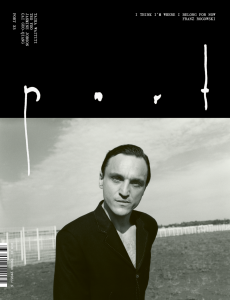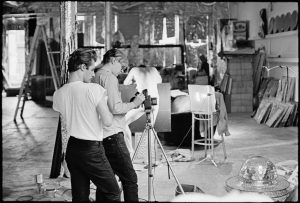Unpicking the threads of the new Barbican show, ‘Re/Sisters’

Laura Grisi’s The Measuring of Time, made in 1969, is one of the earliest works in the Barbican’s ‘Re/Sisters: A Lens on Gender and Ecology’ exhibition. Filmed on 16mm, it depicts the solitary artist on a beach, the camera panning out and around her as she counts grains of sand; an impossible, seemingly endless task that is beyond time, or at least beyond a human-centric impression of time.
Curated by Alona Pardo, ‘Re/Sisters’ makes use of lens-based media – photography and film works, and records of performances, protests, and happenings – to survey the relationship between gender and ecology; drawing connections between the oppression of “women, feminised bodies, and Black, trans and Indigenous communities, and the degradation of the planet”. The works in the exhibition speak to the potential of, and need for, the decentering of human life, in favour of a more intertwined relationship with other species and Earth itself.
A sort-of response to Barbican’s 2020 ‘Masculinities: Liberation through Photography’ show, also curated by Pardo, the exhibition “shines a light on how, since the 1960s, artists, and particularly women and gender-non-conforming artists, have resisted and protested the destruction of life on earth by recognising their planetary interconnectedness”. As ‘Masculinities’ looked at the construction of the male gender and form through the shifting and various eyes of society, ‘Re/Sisters’ flips the perspective to convey how women, and othered people, see the world.
“Women are the largest majority on the planet, but within that there is a greater intersectionality,” Pardo says. “The exhibition is looking at how marginalised bodies are seen as a site of extraction, and how the earth is clearly seen as a site of extraction.” ‘Re/Sisters’ has its roots in the ecofeminism of the 1960s, and moves through a variety of perspectives, vantage points, and experiences. In the USA, ecofeminism grew out from anti-nuclear and anti-war activism, and particularly in reaction to the use of Agent Orange, a chemical herbicide used by the US military to clear foliage in Vietnam. The environmental destruction it caused has been recognised as ecocide, and exposure to it caused millions of people to be disabled, develop cancer, and be born with congenital disorders. “A coalition of women began to form, making links between the oppression of earth and the oppression of women,” says Pardo. And although ecofeminism “emerged into a ripple” it never became a wave, “because third-wave feminists saw the connection between women and nature as essentialist”. The exhibition features work from the 1960s to the present day, and for many artists, the language of ecofeminism wouldn’t have necessarily been part of their practice – whether that is through a rejection of it, or their life and work being grounded in other traditions and cultures – but as an “intersectional, radical, decolonial interest in feminism and environmentalism” has re-emerged, there is new potential in framing works within an expanded ecofeminist context.
‘Re/Sisters’ is organised into six chapters, which convey the potential of protest, occupation, care, connection, and fluidity; how directly confronting, refusing, or continuing to work within complex contexts of environmental abuse can be a radical act. In Simryn Gill’s Channel #1, brightly coloured plastic bags, pieces of fabric, and other detritus are photographed strung between trees, on the sand, and lost among the landscape of a coastal town in Malaysia. They resemble clothing on a washing line, or fabric draped across a body, the pictures are beautiful, the waste – a microcosm of the vast quantities that wash up on the shore – acting as a metaphor for the importance of caring for our environment and valuing domestic labour.

Much of the work in ‘Re/Sisters’ carries multiple layers of meaning, to be read according to your familiarity with the subject and experience, or willingness to pay attention, as the stories of othered people are often told. Uýra’s ‘Rio Negro’ sees the artist, biologist and educator borrowing from the aesthetic language of drag to transform into multi-species characters, “fluidly merging the human and nonhuman… calling for a material and spiritual restoration of the ravaged ecologies to which we belong”. Mónica de Miranda’s Salt Island, made up of five meticulously embroidered photographic prints, “considers the complex experience of Afro-diasporic lives and Europe’s colonial past through a Black ecofeminist lens”, embracing rocks and cliff formations as witnesses of ancestral and ecological trauma, “repositories of human experiences and memories”.
The importance of connecting to land, and taking up space as an act of protection rather than domination, is evident in Taloi Havini’s film Habitat, which follows an Indigenous woman as she walks the landscape of an abandoned copper mine in Bougainville, Papua New Guinea, sifting gravel, “excavating the ‘unproductive’ mineral residues of the mine”. In ‘Imágenes de Yagul’, Ana Mendieta “consciously inserts her body into a space of death (on the ancient Zapotec tomb at the pre-Hispanic Mesoamerican site of Yagul), while also recalling ideas of fertility and femininity”, asking us to reflect on both the inevitable demise and potential of the body, our relationship to history, and geological time. In Touch Sanitation, Mierle Laderman Ukeles takes a different approach to communicating time, scale, and ecologies. Ukeles was the first (unpaid) artist in residence at the New York City Department of Sanitation, her project represents the human scale of the complex bureaucracy of the state, as the artist set out to shake the hand of every NYC refuse collector over the course of a year, thanking them for “keeping New York City alive!”
Susan Schuppli’s film Cold Rights – inspired by Inuk activist Sheila Watt-Cloutier’s petition to the Inter-American Commission on Human Rights in 2005 arguing for the right of ice to remain cold – “offers a space to think differently”, Schuppli tells me. “To ask what a climatic sense of justice might be, in the face of inequalities and injustices that communities experience not only because of climate change, but also when environmental conditions are instrumentalised as weapons against them.” Schuppli is an artist and researcher based the UK, whose work “examines material evidence from war and conflict to environmental disasters and climate change”; she is Director of the Centre for Research Architecture at Goldsmiths, University of London, and Board Chair of Forensic Architecture. Of her practice, Schuppli says: “I tend to think of it as a constellation of things, including workshops, lectures, and films. I want to tell a story, and it is often a complicated story. My practice has specific sonic attributes, field recordings, using acoustics as a way of producing psychological space, and heightening the emotional quality of images through sound.”
Cold Rights is part of a broader framework of research called Learning from Ice, “looking at the knowledge practices mediated by this very ordinary, but also very extraordinary material”. Schuppli’s focus has been on the cryosphere, the frozen water part of the Earth system where people live, and what it means to have the right to be cold: “On behalf of Indigenous communities, whose life worlds are entirely reliant on the material integrity of their environments, which requires that they stay in a state of deep freeze. And what about the rights of materials themselves?” Cold Rights draws together Schuppli’s reflections on research she had been conducting with Forensic Architecture, a series of ‘Cold Cases’ looking at the weaponisation of cold – ice, temperature conditions, and water – in North America. “I wouldn’t say it pushes back at the violence being examined through the Cold Case videos, but it offers a space to think differently.”
The six chapters of ‘Re/Sisters’ – Extractive Economies/Exploding Ecologies; Mutation: Protest and Survival; Earth Maintenance; Performing Ground; Reclaiming the Commons and Liquid Bodies/Fluid Entities – move through actions and reactions that defend, care for, and convene with the more-than-human, grounded in an expansive understanding of gender and ecology.
When establishing the tone of the exhibition, Pardo sought to “call out injustices, while celebrating Earth’s generative potential”. ‘Re/Sisters’ isn’t suggesting a utopian future, but the artists – and activists – in the show convey the power of resistance to patriarchal norms, extractive practices, and the Anthropocene. “Why don’t we break apart the binary world that we live in,” Pardo says, “and try to think through a third way?”
‘Re/Sisters: A Lens on Gender and Ecology’ runs at the Barbican from 5th October 2023–14th January 2024

This article is taken from Port issue 33. To continue reading, buy the issue or subscribe here




